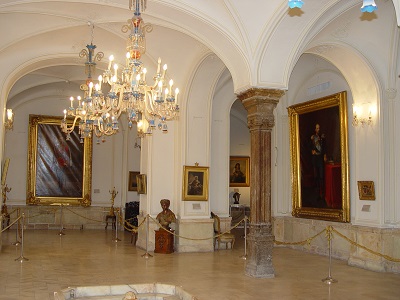

European Painting Gallery (Howz Khaneh)
The travel of the Qajar kings to Europe, which begins with the first trip of Naser al-Din Shah Qajar (Saturday, April 19, 1873), is in fact a turning point in the history of Howz Khaneh, as this place in the same years and after the return of Naser al-Din Shah, underwent some architectural transformation and it was completely rebuilt in a European style, and after many years (about 130 years later), it was decorated with works that show this impact. As we can see, it affected the entire face of Golestan Palace, from the architecture and related elements (such as tiling, etc.) to the most private aspects (dressing of women in the harem, etc.). Although the beginning of Europe's journeys is much more complicated than a simple royal determination, and the reasons for it should be the lack of progress and development in Iran and eastern countries on the one hand, and the dissemination of the knowledge and sciences of the western countries on the other hand, and the fact that the Qajar kings realized this matter and recognized the need for searching and applying new sciences and technologies.
Naser al-Din Shah started the promotion of industries and arts in Iran in a limited way, far from the democracy and civil liberties of the west, he thought he could use new sciences without reducing his power. The desire for progress was not possible without considering the rights of the nation. Naser al-Din Shah was assassinated on Friday, May 1, 1896. His assassination increased the trend of reformism in Iran and destroyed his system of autocracy. His successor, Mozaffar al-Din shah understood the process of changes and its necessity and gained awareness about the fact that the process of reforms in Iran is inevitable, these events and fundamental changes in the equations of the world, such as the defeat of the Russian empire – the superpower of that time - from Japan - a country that started reforms at the same time as Iran - persuaded Muzaffar al-Din Shah to sign the constitutional decree on August 6, 1906. Muzaffar al-Din Shah, like his father, visited Europe 3 times.
The Objects in Howz Khaneh that could have been a reminder of a turning point in the leap towards the development of this country, unfortunately, today is a reminder of the goal and purpose that was not realized. The fact is that the arrangement of the works in Howz Khaneh have been done based on the historical approach of these works from the very beginning and it has been taken into consideration in the selection of paintings. This assumption prevailed over the aesthetic aspect of the works and it is completely evident. In order to work on objects, attention has been paid to two aspects of knowing and analyzing objects.
By looking at the travelogues and studying the history of the works and personalities, we found out that the works in Howz Khaneh are mostly related to the era of Naser al-Din Shah and Muzaffar al-Din Shah Qajar, due to the fact that these two kings had made a total of 6 foreign trips and that they were in power nearly 60 years.
Research work is being done on a small number of works and in addition to the methods used, correspondence with the prestigious centers of the world - museums and research centers - and exchanging information with such centers are part of the future programs.
Howz Khaneh was built in Naseri period and probably in 1863 AD. Of course, the evidence shows that after the return of Naser al-Din Shah from his first trip in 1873 AD, major changes were made in this building, the architects who were involved in these projects have not been identified yet. But there is a possibility that Haji Abul hasan Memar Nawai - known as Memar Bashi or Sani al-Malik Isfahani – has done this work under the supervision of Mirza Yahya Khan Motamed al-Molk. Yahya Khan was the brother of Mirza Hossein Khan, Sepah salar, the chancellor of Nasir al-Din Shah, and the founder of the Sepah salar mosque and school, and the fourth husband of Ezat al-Dowlah, Naser al-Din Shah's sister. These changes were done mostly in order to harmonize the exterior of the Ivory Hall with the new buildings of Salam and Mirrors, in such a way that the porch of Ivory Hall and the Howz khaneh was removed and its space became part of the hall. This can be recognized from the columns in the ivory hall and also from the pictures which show the previous situation. However, there are many words about which places were called Howz khaneh or pond house, but it should be kept in mind that this name can be applied to places that have a specific type of architecture. Because of the lack of valid documents, we are not sure about its usage unless we limit the use of this hall to a place with cool air that was used as a summer chamber. The oral documents, which are mostly from the people who worked in this place, indicate that this place was used for religious festivals and ceremonies during the second Pahlavi period.
In 1997, according to the plan that was prepared for this place, and taking into account the special form of architecture, which was very different from other parts of Golestan Palace complex and its similarity with European architecture, it has been dedicating for exhibiting some paintings as well as the objects presented by European kings to the Qajar court, and in April 2010, the eastern part of Howz khaneh has been used for displaying visual documents taken from the Golestan Palace albums archive.